Jane
Ingram Allen
Made In Taiwan
Tainan
April 3 - 15, 2005
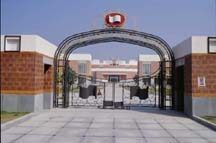
Host Organization: Tainan National University of the Arts
Tainan National College of the Arts
66 Ta-chi, Kuan-tien,
Tainan 720, Taiwan
Contact person: Wen-Ying Huang, Assoc. Professor
Graduate Institute of Applied Arts, Fiber Division
Email: wynhuang@mail.tnca.edu.tw
http://web.tnca.edu.tw/%7Eappart/chinese/map/appart-c-f-m-m/fiber/index1.htm
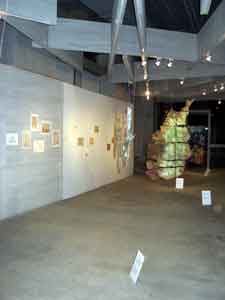
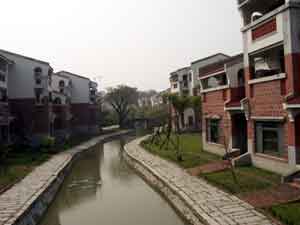 We
have arrived in Tainan after a very fast ride on the express train from
Taipei. We did some shopping at Tesco, a department store offering many
things from clothes to groceries. One of the students from the University
had picked us up at the train station and was kind enough to carry us
around. The University is one hour from Tainan City so it is a bit outside
the hussle and bussle of the city. It is definitely quieter with the exception
of the birds, frogs and insects. The campus is not large, but it is very
beautiful and lots of art going on.
We
have arrived in Tainan after a very fast ride on the express train from
Taipei. We did some shopping at Tesco, a department store offering many
things from clothes to groceries. One of the students from the University
had picked us up at the train station and was kind enough to carry us
around. The University is one hour from Tainan City so it is a bit outside
the hussle and bussle of the city. It is definitely quieter with the exception
of the birds, frogs and insects. The campus is not large, but it is very
beautiful and lots of art going on.
On this first day we focused on unpacking our personal items and then went to the studio space at the Fiber Arts classrooms. We also hung the exhibition at the university gallery in an expansive space. It was fun to work in this space, and we had five of Wen-ying Huang's students to help. They hung the community works for the exhibition, and then five of Wen-ying Huang's students helped us with installing Jane's site maps.
We are staying in faculty housing that is very nice and comfortable. The apartments are located on each side of a canal. We have a living room, bedroom and kitchen. We are looking forward to our stay here.
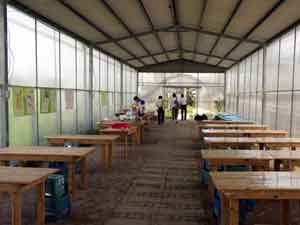
 On
our first full day at the University we were taken to a number of very
interesting places. Our first stop was at the community of San She to
look at the paper making workshop area and garden full of mulberry trees
and other interesting plants. The mulberry trees here are used for
feeding silkworms and for making mulberry wine and vinegar from the berries.
As the silk industry is no longer so strong in Tainan county, they are
trying to find other uses for the mulberry trees and papermaking is one
thing they are trying. Mulberry tree bark is one of the best fibers
for papermaking. Jane will be teaching her community papermaking
art workshop on Saturday and Sunday at this place. It will be a
very good location and a great place to make paper.
On
our first full day at the University we were taken to a number of very
interesting places. Our first stop was at the community of San She to
look at the paper making workshop area and garden full of mulberry trees
and other interesting plants. The mulberry trees here are used for
feeding silkworms and for making mulberry wine and vinegar from the berries.
As the silk industry is no longer so strong in Tainan county, they are
trying to find other uses for the mulberry trees and papermaking is one
thing they are trying. Mulberry tree bark is one of the best fibers
for papermaking. Jane will be teaching her community papermaking
art workshop on Saturday and Sunday at this place. It will be a
very good location and a great place to make paper.
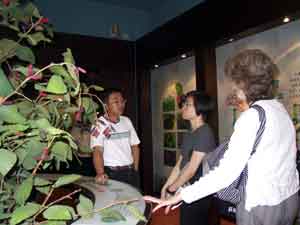 We
were then taken to the San She museum and exhibition site to see the exhibitions
about silk making and the production of products. This museum had great
exhibits on how silk was made and the endless products that are being
produced. San She celebrates an annual silk festival, unfortunately, it
is not going to be held this year because of the lack of funds. It turns
out that Jane's workshop will be a major activity that will substitute
for the silk festival. Jane was not aware of this until we attended the
news conference held at a local restaurant. This followed our visit to
museum.
We
were then taken to the San She museum and exhibition site to see the exhibitions
about silk making and the production of products. This museum had great
exhibits on how silk was made and the endless products that are being
produced. San She celebrates an annual silk festival, unfortunately, it
is not going to be held this year because of the lack of funds. It turns
out that Jane's workshop will be a major activity that will substitute
for the silk festival. Jane was not aware of this until we attended the
news conference held at a local restaurant. This followed our visit to
museum.
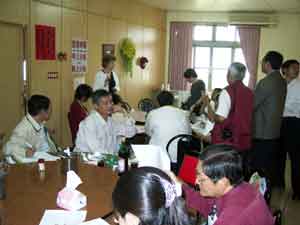 Jane
met the newly elected Chairman of the Agriculture Association. There were
also many reporters there as well. Many of them were enjoying the mulberry
wine. There seemed to be a number of informal drinking contests going
on around us. Following the lunch we returned to the paper studio and
Jane demonstrated paper making for some of the reporters using a single
dip method. The paper makers here used a frame and deckle, but they kept
the newly formed sheet of paper on the wire and used a drying table to
get it dry quickly. It will be interesting to see how Jane's method
of paper making will be received by the participants in the workshop.
After
Jane
met the newly elected Chairman of the Agriculture Association. There were
also many reporters there as well. Many of them were enjoying the mulberry
wine. There seemed to be a number of informal drinking contests going
on around us. Following the lunch we returned to the paper studio and
Jane demonstrated paper making for some of the reporters using a single
dip method. The paper makers here used a frame and deckle, but they kept
the newly formed sheet of paper on the wire and used a drying table to
get it dry quickly. It will be interesting to see how Jane's method
of paper making will be received by the participants in the workshop.
After 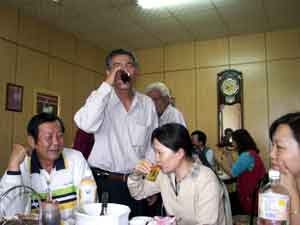 the
reporters left, we went out to the garden and selected plants that would
be good for papermaking. Our host at the papermaking workshop,
Peter, had three different types of Mulberry trees and each appeared to
make paper. We selected two. We also selected a tree that produces a
the
reporters left, we went out to the garden and selected plants that would
be good for papermaking. Our host at the papermaking workshop,
Peter, had three different types of Mulberry trees and each appeared to
make paper. We selected two. We also selected a tree that produces a 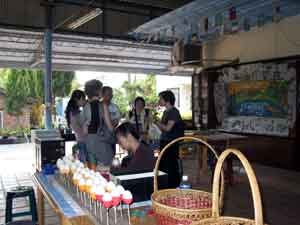 fruit
called "Buddha's head" as it is shaped like a head and has lots
of bumps.
fruit
called "Buddha's head" as it is shaped like a head and has lots
of bumps.
Once we picked these plants, we went to a goose farm where they are using goose eggs to decorate. Raising geese here is a big business. Jane painted a couple of eggs for them. One of them was a map of Taiwan, of course. We decided to stop at an area to see the Tainan County official bird and to see a nut that is grown exclusively in Tainan county. It is like a water chestnut and looks like upturned lips in a smile. Someone pointed out it looked like Tim's handlebar mustache.
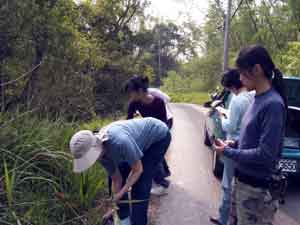 Our
second full day in Tainan was spent collecting additional plants for paper
making. A group of students took us into the hills behind the university
to collect plants.
Our
second full day in Tainan was spent collecting additional plants for paper
making. A group of students took us into the hills behind the university
to collect plants.  We
found a couple of suitable plants, one of which has a bright red flower
that can be used for dyeing they told us. We also selected coconut palm
leaves. The coconut tree was located on the property of one of the students.
While there we had tea and snacks. She had a funny dog named Lulu who
wore a basket over her head to prevent her from biting a sore on her leg.
After stopping there, we went to lunch and then back to the University
to begin to cut up and cook the plants collected today and the day before.
We
found a couple of suitable plants, one of which has a bright red flower
that can be used for dyeing they told us. We also selected coconut palm
leaves. The coconut tree was located on the property of one of the students.
While there we had tea and snacks. She had a funny dog named Lulu who
wore a basket over her head to prevent her from biting a sore on her leg.
After stopping there, we went to lunch and then back to the University
to begin to cut up and cook the plants collected today and the day before.
Today we continued to work on making pulp from the plants we collected. We have 6 plants that we will use here in Tainan. There are many more, but we do not have the time to collect and process them all. We were able to cook all of the remaining plants, clean the fiber and then beat them. Unfortunately, our blender failed, and we had to use one that the school had available.
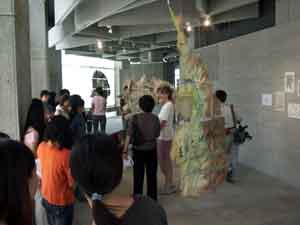
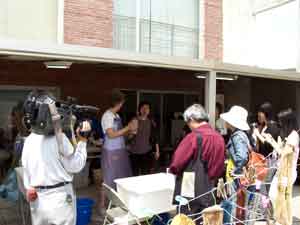 This
morning there was a new conference where many reporters came to Jane's
exhibit and then to her studio area to watch her make paper. She talked
to the reporters and many university students in the gallery about the
various locations where she has been and how each area influences her
work. She also explained how her site maps reflect the culture and people
of each area and become a record of her experience of each place.
Many of the reporters and students asked interesting questions about the
works and the concepts behind them.
This
morning there was a new conference where many reporters came to Jane's
exhibit and then to her studio area to watch her make paper. She talked
to the reporters and many university students in the gallery about the
various locations where she has been and how each area influences her
work. She also explained how her site maps reflect the culture and people
of each area and become a record of her experience of each place.
Many of the reporters and students asked interesting questions about the
works and the concepts behind them.
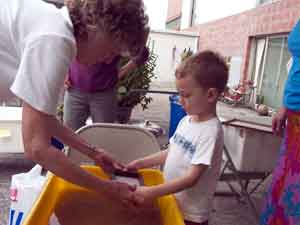 In
the afternoon Jane made paper from the plants of Tainan area and demonstrated
her process for some of the students and visitors to the studio area.
One of the visitors was Leo, the three-year old son of visiting professor
Catherine Liu, also a Fulbright Scholar. Jane helped Leo make a
sheet of paper, and he plans to come back tomorrow to try some more papermaking.
At the end of the day Jane had made samples of all the 6 plants and had
begun to make paper that will be used in the Tainan Site Map.
In
the afternoon Jane made paper from the plants of Tainan area and demonstrated
her process for some of the students and visitors to the studio area.
One of the visitors was Leo, the three-year old son of visiting professor
Catherine Liu, also a Fulbright Scholar. Jane helped Leo make a
sheet of paper, and he plans to come back tomorrow to try some more papermaking.
At the end of the day Jane had made samples of all the 6 plants and had
begun to make paper that will be used in the Tainan Site Map.
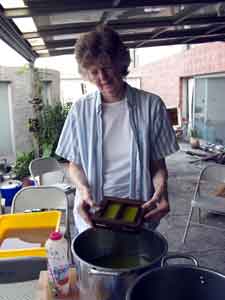 Today
Jan concentrated on making sheets of paper from the Tainan plants to use
in making her site maps. All of the plats made interesting paper.
We tried two more plants today that were brought in by some of the students.
One of them was rice straw, and rice is certainly plentiful in Tainan
County.
Today
Jan concentrated on making sheets of paper from the Tainan plants to use
in making her site maps. All of the plats made interesting paper.
We tried two more plants today that were brought in by some of the students.
One of them was rice straw, and rice is certainly plentiful in Tainan
County. 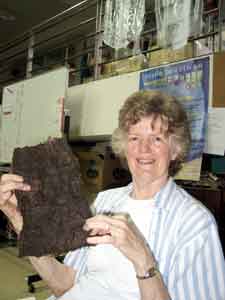 We
can see many green fields of young rice, and the rice straw is the left
over from last year's crop. We also used a reddish colored long
bladed grass that was growing at the home of Shu Yen near the university.
The rice straw paper is interesting but the fiber is not so strong.
The red grass made a bright green colored paper with very fine fibers.
We
can see many green fields of young rice, and the rice straw is the left
over from last year's crop. We also used a reddish colored long
bladed grass that was growing at the home of Shu Yen near the university.
The rice straw paper is interesting but the fiber is not so strong.
The red grass made a bright green colored paper with very fine fibers.
We will have to wait until tomorrow when they are dry to see how both of these papers turn out. Some students also came in late in the afternoon to help with beating the fibers and getting things prepared for the workshop tomorrow and Sunday. Tomorrow begins the two-day public workshop in papermaking to be held in a nearby community known for silk production.
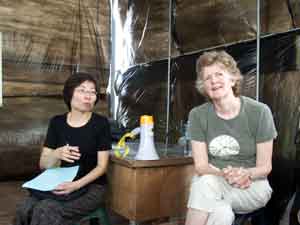
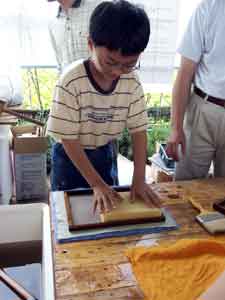 Today
was the first day of a very successful workshop held in a community about
20 minutes from the Art University in Tainan County. This community
used to specialize in silk production but with the competition from China
and Southeast Asia, it isnow producing mulberry wine and vinegar from
the mulberry trees formerly used for silkworm feeding. The workshop began
with Jane giving a talk and showing photos about the possibilities of
making art with paperm. She talked about how paper is made, how
it has been used and some about her own art work using hand papermaking..
After that, the participants learned how to make paper using the Western
method or single dip method. They enjoyed making paper and then stacking
the sheets with felt in between on wooden blocks to press. The press was
the participants standing on a table that was placed on top of the the
stack of paper. They then took the individual sheets and brushed them
on to various objects, including trees, plants, rocks and any other surface
that they could fine.
Today
was the first day of a very successful workshop held in a community about
20 minutes from the Art University in Tainan County. This community
used to specialize in silk production but with the competition from China
and Southeast Asia, it isnow producing mulberry wine and vinegar from
the mulberry trees formerly used for silkworm feeding. The workshop began
with Jane giving a talk and showing photos about the possibilities of
making art with paperm. She talked about how paper is made, how
it has been used and some about her own art work using hand papermaking..
After that, the participants learned how to make paper using the Western
method or single dip method. They enjoyed making paper and then stacking
the sheets with felt in between on wooden blocks to press. The press was
the participants standing on a table that was placed on top of the the
stack of paper. They then took the individual sheets and brushed them
on to various objects, including trees, plants, rocks and any other surface
that they could fine.
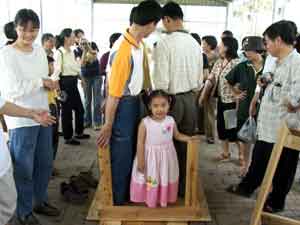
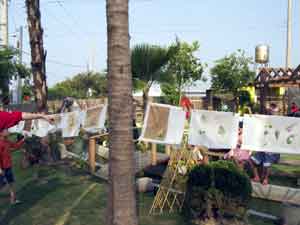 After
lunch they learned about the plants that could make paper and then prepared
three plants for cooking. The three were mulberry, a fruit called Buddha
head and Japanese Silver Grass. Once prepared they were put into cooking
pots with water and put on to boil and cook. The participants then returned
to making paper after Jane showed them the modified Asian method. They
made some excellent paper and hung them out to dry in the sun.
After
lunch they learned about the plants that could make paper and then prepared
three plants for cooking. The three were mulberry, a fruit called Buddha
head and Japanese Silver Grass. Once prepared they were put into cooking
pots with water and put on to boil and cook. The participants then returned
to making paper after Jane showed them the modified Asian method. They
made some excellent paper and hung them out to dry in the sun.
Tomorrow they will continue to make paper in the morning and then learn some mixed media techniques for making art with the dried handmade paper sheets in the afternoon.
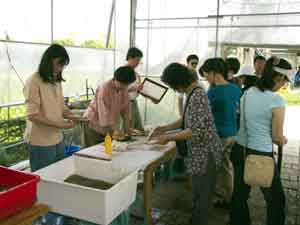
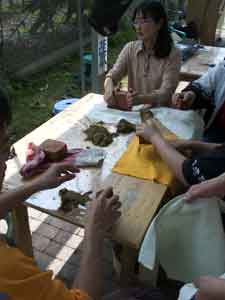
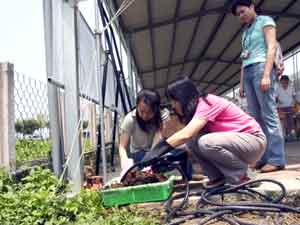 The
workshop was highly successful with many people enjoying learning about
papermaking. There were also a number of very serious learners who diligently
took notes. On the second day of the workshop, participants continued
to make paper but also learned about preparing fibers from the three plants
that were cooked the day before. They cleaned the fibers, cut them into
shorter lengths and then beat them. Two of the bark fibers required blending,
and this was done as well. They used these new fibers to make handmade
paper.
The
workshop was highly successful with many people enjoying learning about
papermaking. There were also a number of very serious learners who diligently
took notes. On the second day of the workshop, participants continued
to make paper but also learned about preparing fibers from the three plants
that were cooked the day before. They cleaned the fibers, cut them into
shorter lengths and then beat them. Two of the bark fibers required blending,
and this was done as well. They used these new fibers to make handmade
paper.
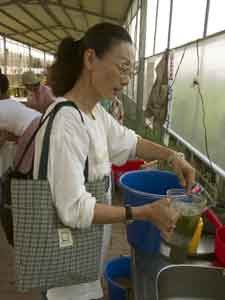 Just
after lunch we took all of the remaining fibers and combined them into
one mixture. We placed a large sheet of window screening outside on the
grass ,and Jane showed the group the pouring method of making paper.
The group began to pour the
Just
after lunch we took all of the remaining fibers and combined them into
one mixture. We placed a large sheet of window screening outside on the
grass ,and Jane showed the group the pouring method of making paper.
The group began to pour the 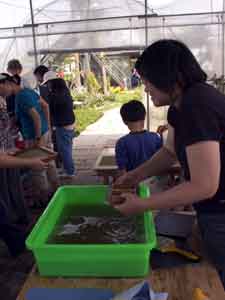 combined
pulp onto the screening making a large collaborative handmade paper artwork.
The participants then added flowers and other objects. One put their hand
down and poured pulp around it. Another put the characters of the place
onto the wet pulp. Overall, it turned out to be a very interesting
group project. When we went back later to move the piece from the grass
to the sidewalk, we discovered that a child had walked onto the artwork
and left his sneaker footprints. The footprints added a nice touch that
was not planned for at the beginning.
combined
pulp onto the screening making a large collaborative handmade paper artwork.
The participants then added flowers and other objects. One put their hand
down and poured pulp around it. Another put the characters of the place
onto the wet pulp. Overall, it turned out to be a very interesting
group project. When we went back later to move the piece from the grass
to the sidewalk, we discovered that a child had walked onto the artwork
and left his sneaker footprints. The footprints added a nice touch that
was not planned for at the beginning.
For the rest of the afternoon, the participants took some of their dried
handmade paper and combined them with other media to make unique handmade
paper artworks. They used paint, acrylic gel, and other objects to create.
One individual created a handmade paper cup by forming wet paper around
a plastic 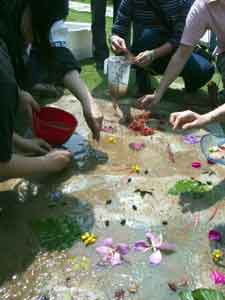 cup
and then removing the plastic cup when the paper was dry. Maybe
he will make a small night light with this handmade paper cup shape.
cup
and then removing the plastic cup when the paper was dry. Maybe
he will make a small night light with this handmade paper cup shape.
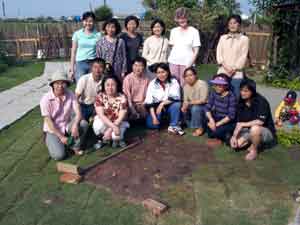 Prior
to ending the day, the individual who harvested the water plants that
grow the nuts came by to see the paper that the plant made. Jane gave
him a sheet of paper from the plant. He was quite pleased. We closed the
day with a group photo of everyone. We will pick up the works made in
the workshop to take it to the University to install after it is dried.
Prior
to ending the day, the individual who harvested the water plants that
grow the nuts came by to see the paper that the plant made. Jane gave
him a sheet of paper from the plant. He was quite pleased. We closed the
day with a group photo of everyone. We will pick up the works made in
the workshop to take it to the University to install after it is dried.
We had dinner at a very good restaurant and enjoyed a long discussion about art and culture with Wen-Ying and three of her students. We then went in search of a pineapple. We found an excellent one at a roadside stand.
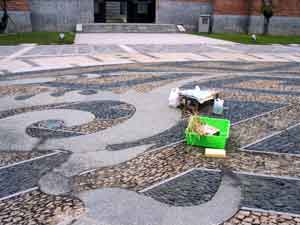
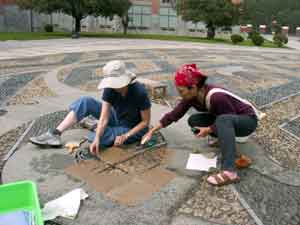
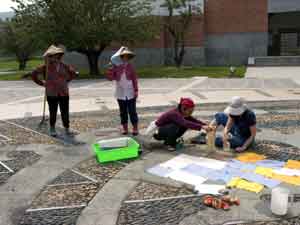
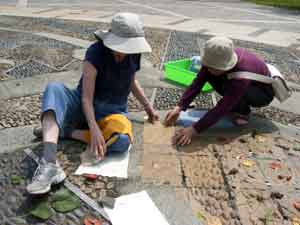 The
process of paper making has now been completed, and Jane has begun to
work on the Tainan Site maps. For one of the maps she and Tim made over
60 sheets of paper from the various plant fibers that had been discovered
during the previous days. Once the sheets of paper were made they were
taken to the center court yard of the school and placed on the concrete
and rock surfaces in the shape of a Tainan County map. The surface created
an intersting relief impression in the paper..
The
process of paper making has now been completed, and Jane has begun to
work on the Tainan Site maps. For one of the maps she and Tim made over
60 sheets of paper from the various plant fibers that had been discovered
during the previous days. Once the sheets of paper were made they were
taken to the center court yard of the school and placed on the concrete
and rock surfaces in the shape of a Tainan County map. The surface created
an intersting relief impression in the paper..
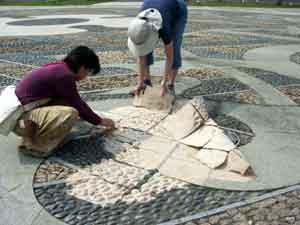
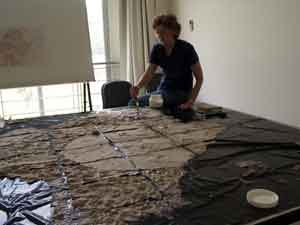 Once
the paper was placed, string was put down to connect the sheets
of paper. Jane also added flowers, leaves and other natural objects to
the surface. Another layer of paper was put on top to hold everything
together. By the time we finished, it was so hot that it was necessary
to keep spraying the paper to keep it from drying as we worked.
Once the piece was completed, it took a couple of hours to completely
dry and then was taken up and brought into the studio area where Jane
began to work on preparing and painting some of the surface.
Once
the paper was placed, string was put down to connect the sheets
of paper. Jane also added flowers, leaves and other natural objects to
the surface. Another layer of paper was put on top to hold everything
together. By the time we finished, it was so hot that it was necessary
to keep spraying the paper to keep it from drying as we worked.
Once the piece was completed, it took a couple of hours to completely
dry and then was taken up and brought into the studio area where Jane
began to work on preparing and painting some of the surface.
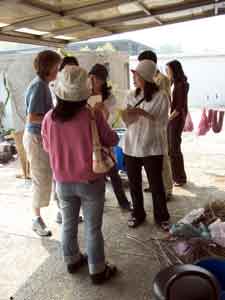

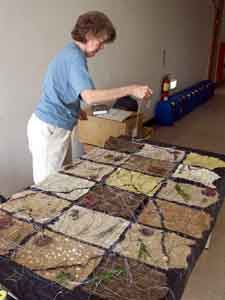
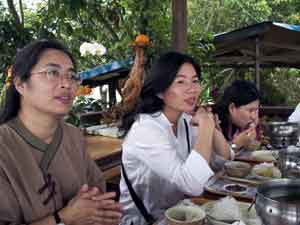 We
had a very pleasant surprise yesterday when a group from Chiayi came to
visit. Meg and Wendy brought with them other people that we had worked
with while staying in Chiayi. They got a chance to look at Jane's work
in the gallery and see the studio where she is currently working. We all
then went to lunch at a very nice restaurant in the mountains of northeast
Tainan County. We ate in a dining area built into large trees. It was
very impressive and a great break from the University's restaurant food.
On the way we spotted some mangos at a fruit stand, and the group purchased
a lot to share. We also met an artist who is a calligrapher and is working
on a two year project at the White River community. This community specializes
in the white lotus. He returned with us to see Jane's exhibit and the
paper that she made from lotus leaves.
We
had a very pleasant surprise yesterday when a group from Chiayi came to
visit. Meg and Wendy brought with them other people that we had worked
with while staying in Chiayi. They got a chance to look at Jane's work
in the gallery and see the studio where she is currently working. We all
then went to lunch at a very nice restaurant in the mountains of northeast
Tainan County. We ate in a dining area built into large trees. It was
very impressive and a great break from the University's restaurant food.
On the way we spotted some mangos at a fruit stand, and the group purchased
a lot to share. We also met an artist who is a calligrapher and is working
on a two year project at the White River community. This community specializes
in the white lotus. He returned with us to see Jane's exhibit and the
paper that she made from lotus leaves.
After we returned, Jane continued to work on her two site maps. One depicts all of Tainan County, and the other focuses on the area around the university and the coral-shaped reservoir that is nearby. This piece includes sheets of paper from all of the 8 plants we used for papermaking here.
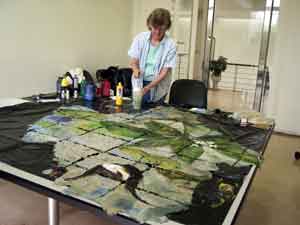
 This
is the last day for Jane to work on the two site maps that she is making
for the Tainan residency. She also worked on the book and signs for the
exhibit that opens tomorrow. She completed them and had time to rest.
This
is the last day for Jane to work on the two site maps that she is making
for the Tainan residency. She also worked on the book and signs for the
exhibit that opens tomorrow. She completed them and had time to rest.
Today is the last full day that we are in Tainan. We installed the two Tainan site maps and the community work in the gallery. They went well with the other works. There was a closingl reception with some of the participants from the workshop and students from the university attending. The exhibition will be on view until 5 PM today and then we will begin packing everything for our next place in Miaoli County. Following the reception we went to photograph one of the plants we has used in Tainan County and then to a local restaurant to have lunch. We walked into the restaurant and saw a large mural on the wall of a Paris street with many European diners. Someone had painted Chinese characters on one of the flower boxes to tie it to the local restaurant. We asked a couple of our hosts to sit infront of the mural and play like they were eating on the French street. The rest of the day we will be packing our boxes to ship them on to Miaoli County for our next stop..

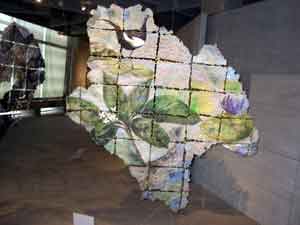
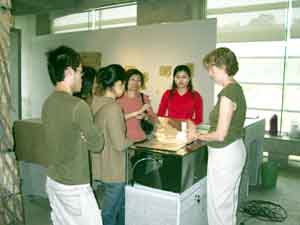
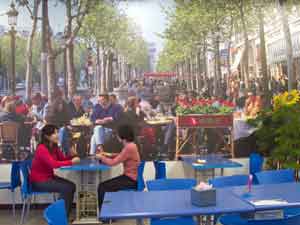
Return to Made In Taiwan home page
(updated on April 14, 2005 )
For more information on Jane, click on one of the icons below







